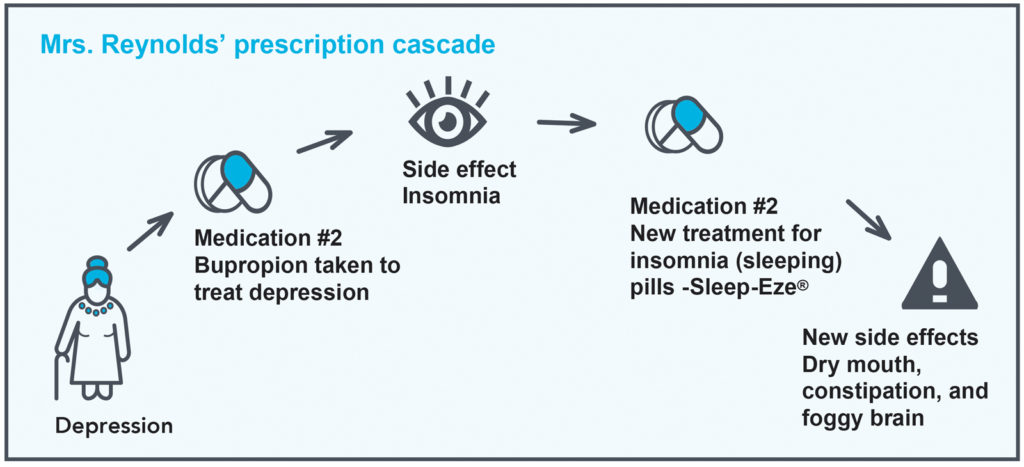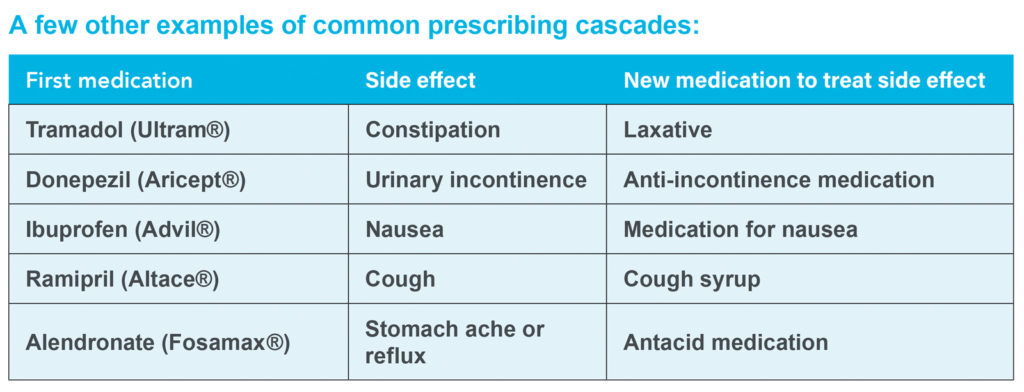What is a prescribing cascade?
A prescribing cascade can happen when you and/or your health providers do not realize new symptoms are actually the side effects of one of your medications. When this happens, you may be diagnosed with a new medical condition. As a result, often your health provider will prescribe a new medication to treat the side effects of the first medication.
Your new medication may also have side effects. When you and/or your health provider interpret these side effects as yet another new health condition, this can lead to more prescriptions. What happens next? Too often, you can end up taking a cascade of new medications which are not needed and which can cause harm.
Whenever you take a medication, there is a risk you will experience a side effect. The more medications you take, the greater your risk of side effects. Whenever you experience new symptoms, you and your health providers should always first consider whether they could be caused by medications you are currently taking. This will help avoid a common preventable problem called a “prescribing cascade.”
Mrs. Reynolds’ story
At 75, Mrs. Reynolds started having trouble falling asleep. She felt like she was spending hours tossing and turning. Her daily routine hadn’t changed: she visited with friends, went for her daily walk, and made sure to keep her coffee consumption low. Her medications hadn’t changed either. She’d been taking medications regularly for depression, high cholesterol and high blood pressure for years.
Hoping it would help her get a good night’s sleep, Mrs. Reynolds bought a box of sleeping pills (Sleep-Eze®) at the
pharmacy and took one that evening. Although it didn’t help, she thought it would be worth trying them a little longer. But over the next few days, Mrs. Reynolds noticed her mouth started feeling dry, which forced her to keep a glass of water on her bedside table. In the mornings, she woke up feeling groggy and constipated. Meanwhile, her sleep hadn’t improved. Feeling frustrated, she decided to go see her pharmacist Nadia about these new symptoms as well as about her sleep problem.

Nadia listened carefully to Mrs. Reynolds’ story. Then, she explained that the most likely cause of her dry mouth, constipation and daytime grogginess was the sleeping pill she’d been taking. Nadia then took a close look at Mrs. Reynolds’ file. She told Mrs. Reynolds her antidepressant (bupropion) could be causing her insomnia in the first place.
“Your sleep problem is likely a side effect of the antidepressant medication you are taking. When you took another medication for your sleep problem, this created what we call a prescribing cascade.” Mrs. Reynolds was puzzled. She had been taking bupropion for over two years. Was it possible new side effects could appear after so much time had passed? The pharmacist’s response was clear: “Yes. You can get a new side effect at any time.”
Identifying side effects
The more medications we take, the greater our risk of harmful effects. When Mrs. Reynolds tried to treat her insomnia with a sleeping pill, she ended up with new side effects (dry mouth, constipation and foggy brain). And if she had tried to treat these new side effects with medications, these new medications may have caused even more side effects. Luckily, Mrs. Reynolds consulted with her pharmacist, who recognized that her new symptoms were side effects. The key to avoiding prescribing cascades is identifying when new symptoms are really side effects.
When a new symptom may be a medication side effect, you and your health provider should consider deprescribing. Deprescribing means reducing or stopping medications that may not be beneficial or that may be causing harm.
Deprescribing should always be done in a planned and supervised manner, in partnership
with your health provider. The goal of deprescribing is to improve your quality of life without compromising your health.

How can you help prevent prescribing cascades?
It is not always easy to identify prescribing cascades, as they may go on for years, and involve many medical conditions, symptoms and medications. Many symptoms, such as fatigue, confusion, dizziness and falls, may actually be side effects of medications, not old age or a new medical condition. These side effects can lead to hospitalizations and changes to your life and well-being. Here are five things you can
do to help prevent prescribing cascades:
1) Ask questions. Have you noticed a new symptom? Ask a health provider this question: “Could this symptom be a side effect of one of my medications?” Do not assume your doctor, pharmacist or nurse is always looking out for side effects of the medications you are taking. If you have a doubt about a medication, ask about it.
2) Don’t forget your non-prescription medications. Non-prescription medications (also known as over-the-counter or OTC medications) and natural health products can also cause side effects and prescribing cascades. The sleeping pill Mrs. Reynolds started taking is just one example.
Be sure to include all non-prescription medications on your list, and share this information with
your health provider(s).
3) Stay informed. Educate yourself about the possible side effects of your medications. New side effects can appear months or even years after taking the same medication, even at the same dose. Remember that even if your medications or dosage hasn’t changed, over time your body, life situation and health change. This can affect the way your body processes medications. Be sure to review all your medications with a health provider at least once a year. This will help ensure you are taking only medications you still need. Each time you add a new prescription, ask for a full review of your medications to ensure it won’t interact with those you already take.
4) Consider deprescribing. When you and your health provider identify a prescribing cascade, it’s important to discuss whether stopping a medication or reducing the dose would be a good option for you. You may decide to put a tapering plan in place to stop a medication gradually.
5) Are there alternatives? Could other, safer treatments (medication or non-medication) help with this health condition?

Back to Mrs. Reynolds
Following their discussion, Nadia offered to contact Mrs. Reynolds’ family doctor to recommend they reduce the dose of her antidepressant (bupropion). Mrs. Reynolds’ family doctor agreed to the change and asked her to follow up with him in a few weeks to check on her mood. Mrs. Reynolds was relieved that the side effects from the sleeping pill disappeared a few days after she stopped taking them.
About two weeks after reducing the dose of her antidepressant, Mrs. Reynolds noticed a definite improvement in her sleep. She also found several of the techniques explained in a brochure her pharmacist gave her on how to get a good night’s sleep to be helpful. Waking up at the same time every day and limiting naps helped improve her sleep at night. Mrs. Reynolds was satisfied. Her conclusion? To avoid taking medications unnecessarily, when new symptoms appeared in future she would make sure to always ask her doctor or pharmacist this question first: “Could this symptom be a medication side effect?”
Camille Gagnon is the Assistant Director of the Canadian Deprescribing Network and is a clinical pharmacist who works in a primary care clinic.
Janet Currie is a social worker who has been involved with patient and medication safety issues for over 17 years. Janet is Chair of the Patient Awareness Committee of the Canadian Medication Appropriateness and Deprescribing Network.
Johanna Trimble is a patient safety advocate and member of the BC Patient Voices Network. She is a member of the Geriatrics and Palliative Care Subcommittee of the Council on Health Promotion for Doctors of BC.













